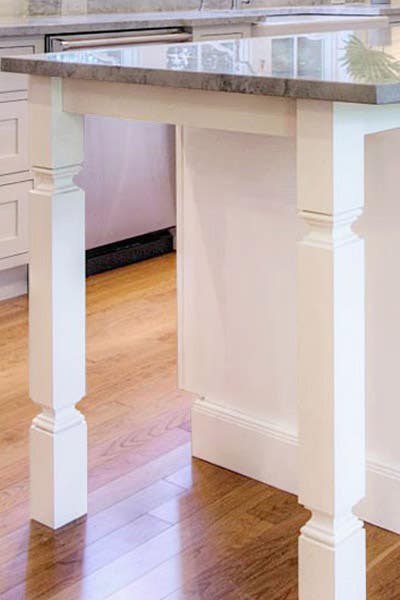Necessary Aspects to Think About When Picking Legs For Kitchen Island
Selecting the proper legs for a kitchen island includes a cautious evaluation of numerous elements that can significantly affect both capability and visual appeal. As we check out these aspects, it becomes clear that each choice can have far-reaching ramifications for the total kitchen experience.
Product Options
When picking legs for a kitchen area island, understanding the different product options is necessary for attaining both visual appeal and architectural honesty (Legs For Kitchen Island). The choice of product significantly affects not just the durability of the island yet additionally its total style and functionality
Timber is a popular option, providing warmth and versatility. Solid woods, such as oak or maple, offer stamina and can be stained or painted to match the kitchen decoration. Steel legs, commonly made from stainless-steel or wrought iron, contribute a commercial and contemporary feeling while making certain sturdiness and security. These products are resistant to put on and can support significant weight, making them perfect for bigger islands.
One more alternative is crafted products, like MDF or plywood, which can be a lot more affordable while still supplying a variety of surfaces. Nevertheless, they may not give the same degree of security as strong timber or steel. Last but not least, materials such as acrylic or glass can produce a contemporary appearance, though they might need added assistance to ensure stability.
Inevitably, the option of material for cooking area island legs ought to align with the wanted functionality and the total style of the kitchen area.
Design And Style

When taking into consideration style, the shape and finish of the legs are crucial. Conical legs can give a feeling of agility and elegance, while thicker, extra durable legs can communicate stamina and security. Additionally, the coating-- be it painted, tarnished, or all-natural-- should match the cabinets and counter top products to create a unified appearance.
Furthermore, the style of the legs can additionally mirror individual taste. Personalized or attractive legs, such as those including elaborate carvings or unique geometric forms, can offer as centerpieces, including character and personality to the kitchen area. Ultimately, the right selection will not only boost functionality however likewise boost the visual appeal, making the kitchen area island a standout attribute of the home.
Elevation Considerations
Choosing the suitable height for kitchen island legs is important, as it straight impacts both capability and convenience. The typical elevation for a kitchen island typically varies from 36 to 42 inches, aligning with usual counter top elevations.

It is likewise vital to represent customers' preferences and heights. Tailoring the height can guarantee a comfy experience for all member of the family, making the kitchen area island a more functional and satisfying space.
Weight Assistance
Guaranteeing ample weight support for cooking area island legs is important for both safety and security and functionality. The cooking area island frequently offers multiple functions, consisting of Your Domain Name cooking, eating, and additional storage space, demanding a robust assistance structure. When selecting legs, it is vital to think about the overall weight capability called for based upon the island's planned use and the products that will certainly be positioned on it.
The choice of material for the legs plays a significant duty in their weight-bearing capacities. Strong timber, steel, and heavy-duty composites generally supply premium strength compared to lighter materials. Furthermore, the style of the legs-- whether they are right, tapered, or have a pedestal kind-- can influence their ability to distribute weight successfully throughout the framework.
Constantly consult the maker's specs regarding load restrictions to make sure that the legs can maintain the desired weight without endangering safety. In summary, selecting kitchen island legs with appropriate weight assistance is vital for producing a practical and safe cooking space.
Installment and Upkeep
Proper installment and maintenance of cooking area island legs are important for guaranteeing longevity and stability. To start, it is necessary to follow the supplier's guidelines throughout installation. This usually includes safeguarding the legs to the island base making use of suitable bolts, guaranteeing that the legs are degree and aligned. Using a degree tool can assist protect against wobbling and improve the total aesthetic charm of the cooking area island.
Once set up, normal upkeep is necessary to protect the honesty and look of the legs - Legs For Kitchen Island. For wood legs, routine cleaning with a moist towel and application of ideal timber gloss can prevent moisture damage and maintain their surface. Metal legs may need a gentle cleaning service to eliminate grease and gunk, complied with by a dry fabric to stop corrosion formation
Additionally, evaluate the legs consistently for indications of wear or damage, such as splits or loose joints. Tightening up screws or bolts as required can likewise prolong the life-span of the legs. By adhering to these installment and maintenance techniques, house owners can guarantee that their cooking area island remains tough and visually appealing for several years to find.
Verdict

Aesthetic comprehensibility is paramount in choosing the design and design of legs for a kitchen island, as these aspects substantially influence the overall atmosphere click to read of the room. Conical legs can provide a sense of lightness and sophistication, while thicker, extra durable legs can convey strength and stability.Selecting the appropriate height for kitchen area island legs is critical, as it directly impacts both functionality and comfort. In summary, selecting kitchen island legs with sufficient weight support is vital for producing a secure and useful cooking area.
In final thought, choosing legs for a kitchen area island requires careful consideration of various factors, consisting of product alternatives, style, height, weight support, and installation.